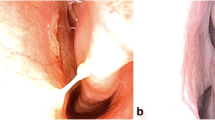Abstract
The objective of the study is to assess the correlation between outpatient department (OPD) assessment and sleep nasendoscopy (SNE) in treatment planning for sleep related breathing disorders. The study design includes a blinded, cohort study comparing the treatment prediction based on OPD clinical evaluation with SNE in consecutive, adult patients by a single clinician with a specialist interest in snoring related disorders. Patients with moderate to severe obstructive sleep apnoea and those who had undergone previous treatment were excluded. The study was conducted in Royal National Throat, Nose and Ear Hospital, London and Queen’s Hospital, Romford. Ninety-four patients were recruited as participants for the study. The main outcome measures include site of obstruction and treatment planning. The results show no significant correlation between the two groups with SNE recommending less surgical intervention and a choice of surgical and non-surgical management in greater number of patients. In conclusion, even in experienced hands, clinical prediction is significantly modified by SNE findings. The addition of SNE to the diagnostic pathway, to assess the three-dimensional dynamic anatomy of the upper airway, provides a valuable adjunct to the OPD assessment of upper airway collapse. This affords the clinician a greater accuracy of diagnosis and the patient a more focussed management strategy with increased choice of modality of treatment.





Similar content being viewed by others
References
Browman CP, Sampson MG, Yolles SF (1984) Obstructive sleep apnea and body weight. Chest 85(3):435–438
Jones TM, Ho MS, Earis JE, Swift AC, Charters P (2006) Acoustic parameters of snoring sound to compare natural snores with snores during ‘steady-state’ propofol sedation. Clin Otolaryngol 31(1):46–52
Battagel JM, Johal A, Kotecha BT (2005) Sleep nasendoscopy as a predictor of treatment success in snorers using mandibular advancement splints. J Laryngol Otol 119(2):106–112
Berry S, Roblin G, Williams A, Watkins A, Whittet HB (2005) Validity of sleep nasendoscopy in the investigation of sleep related breathing disorders. Laryngoscope 115(3):538–540
Georgalas C, Kotecha B (2004) Predictive value of sleep nasendoscopy in the management of habitual snorers. Ann Otol Rhinol Laryngol 113(5):420 Comment
Camilleri AE, Ramamurthy L, Jones PH (1995) Sleep nasendoscopy: what benefit to the management of snorers? J Laryngol Otol 109(12):1163–1165
Croft CB, Pringle MB (1991) Sleep nasendoscopy: a technique of assessment in snoring and obstructive sleep apnoea. Clin Otolaryngol 16:504–509
Counter P, Wilson JA (2004) The Management of Simple Snoring. Sleep Med Rev 8(6):433–441
American Academy of Sleep Medicine Task Force (1999) Sleep-related breathing disorders in adults: recommendations for syndrome definition and measurement techniques in clinical research. Sleep 22:667–689
Johns MW (1993) Daytime sleepiness, snoring and obstructive sleep apnoea: the Epworth Sleepiness Scale. Chest 103:30–36
Quetelet LAJ (1842) A treatise on man and the development of his faculties. Scholars Facsimilies and Reprint. ISBN 0820110612
Li W, Ni D, Jiang H, Zhang L (2003) Predictive value of sleep nasendoscopy and the Müller maneuver in uvulopalatopharyngoplasty for the obstructive sleep apnea syndrome. J clin otorhinolaryngol 17(3):145–146 Lin Chuang Er Bi Yan Hou Ke Za Zhi
Liistro G, Stanescu D, Veriter C (1991) Pattern of simulated snoring is different through mouth and nose. J Appl Physiol 70:2736–2741
Pringle MB, Croft CB (1993) A grading system for patients with obstructive sleep apnoea-based on sleep nasendoscopy. Clin Otolaryngol 18:480–484
Hill PD, Osman EZ, Osbourne JE, Lee BWV (2000) Changes in snoring during natural sleep identified by acoustic crest factor analysis at different times of night. Clin Otolaryngol 25:507–510
Agrawal S, Stone P, McGuinness K, Morris J, Cameilleri AE (2002) Sound Frequency analysis and the site of snoring in natural and induced sleep. Clin Otolaryngol 27:162–166
Badawey MR, McKee G, Heggie N, Marshall H, Wilson JA (2003) Predictive value of sleep nasendoscopy in the management of hjabitual snorers. Ann Otol rhino Laryngol 112(1):40–44
Saunders NC, Tassone P, Wood G, Norris A, Harries M, Kotecha B (2004) Is acoustic analysis of snoring an alternative to sleep nasendoscopy? Clin Otolaryngol Allied Sci 29(3):242–246
Ritter CT, Trudo FJ, Goldberg AN, Welch KC, Maislin G, Schwab RJ (1999) Quantative evaluation of the upper airway during nasopharyngoscopy with the Muller manouevre. Laryngoscope 109(6):954–963
Johal A, Battagel JM, Kotecha BT (2005) Sleep nasendoscopy: a diagnostic tool for predicting treatment success with mandibular advancement splints in obstructive sleep apnoea. Eur J Orthod 27(6):607–614
Kotecha BT, Hannan A, Khalil HMB, Georgalas C, Bailey P (2007) Sleep nasendoscopy: a 10 year retrospective audit study. Eur Arch Otorhinolaryngol 264:1361–1367
Stuck BA, Maurer JT (2007) Airway evaluation in obstructive sleep apnea. Sleep Med Rev (Epub ahead of print)
Conflict of interest
The authors declare that they have no conflict of interest.
Author information
Authors and Affiliations
Corresponding author
Appendix
Appendix


Rights and permissions
About this article
Cite this article
Hewitt, R.J.D., Dasgupta, A., Singh, A. et al. Is sleep nasendoscopy a valuable adjunct to clinical examination in the evaluation of upper airway obstruction?. Eur Arch Otorhinolaryngol 266, 691–697 (2009). https://doi.org/10.1007/s00405-008-0831-5
Received:
Accepted:
Published:
Issue Date:
DOI: https://doi.org/10.1007/s00405-008-0831-5




